Articles Menu
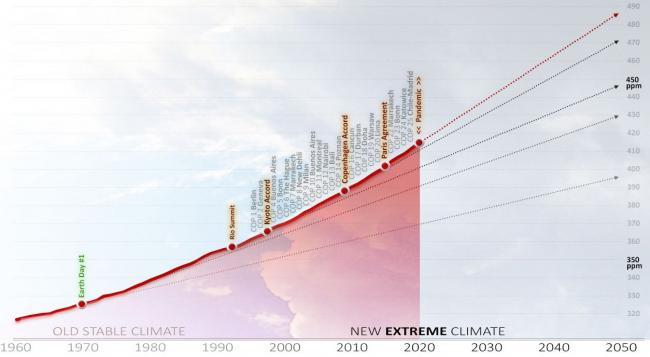
April 26th 2021
“Whatever our world leaders are 'doing' to reduce emissions, they are doing it wrong … Our political leaders have failed us … We have to understand what the older generation has dealt to us, what mess they have created that we have to clean up and live with.” — Greta Thunberg
The primary force overheating our planet, destabilizing our climate, and acidifying our oceans is the CO2 humans are dumping into the atmosphere.
Despite decades of Earth Days, international climate summits and even an epic economic contraction caused by a global pandemic, the amount of CO2 piling up in our atmosphere hasn't stopped rising. Or even slowed down a bit. Instead, CO2 levels have continued to accelerate upwards, unchecked.
That's the dismal story revealed by the most recent CO2 data from the United States National Oceanic and Atmospheric Administration (NOAA). Take a look.

The bold red line in my chart shows the surging level of CO2 in our atmosphere since 1960. You can easily see the accelerating rise by looking at the dotted lines I've added. These show how fast CO2 was rising in each decade.
For example, in 1970, as people rallied for the first Earth Day, humans were increasing the CO2 in the atmosphere by an average of 0.9 parts per million (ppm) every year.
By 1992, when the world's nations gathered for the Rio Summit, humans were increasing it by 1.5 ppm per year — 60 per cent faster.
Now, after a quarter century of international climate summits (officially called United Nations Conference of the Parties, or COPs), we are increasing CO2 in the atmosphere by 2.4 ppm per year — nearly three times faster than during that first Earth Day. And last year, during the global pandemic, CO2 rose even faster still, by 2.6 ppm.
Climate summits have failed to slow the increase of carbon emissions into the Earth's atmosphere, and Canada must accept some of the blame, @bsaxifrage writes for @NatObserver. #Earth #ClimateCrisis - Twitter
"We have let down the young generation, and they know it, and they are angry." — Sir David Attenborough
There is no mystery about the primary cause of this accelerating rise — burning fossil fuels. My next chart shows this clearly.
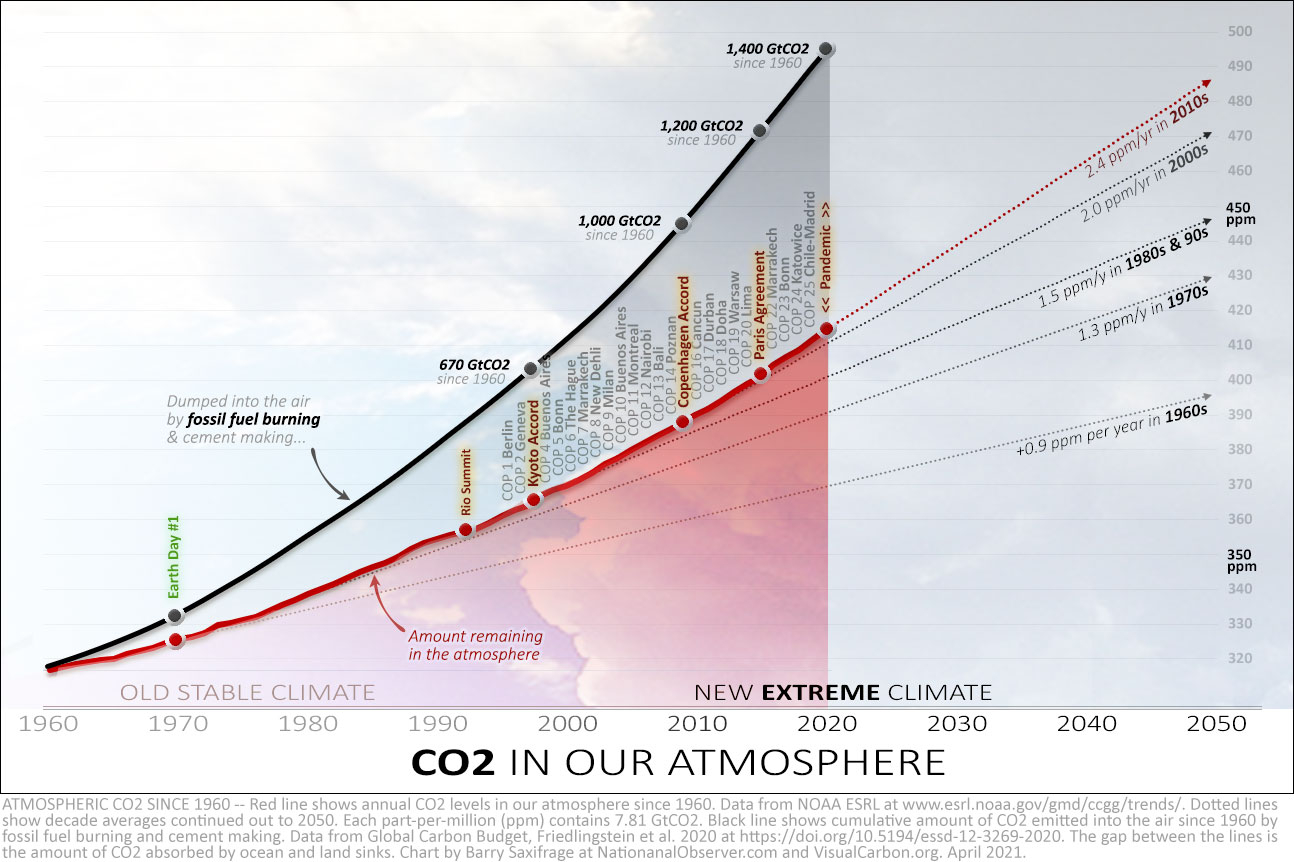
The bold black line I added to the chart shows the cumulative amount of CO2 dumped into the air since 1960 from fossil fuel burning, plus a bit from cement making.
As you can see, that black fossil fuel pollution line has accelerated upwards, as well. In fact, the top 10 greatest fossil fuel burning years in history were 2010 to 2019 — with each year breaking the record set the year before.
Yes, global fossil fuel emissions fell a bit in 2020 because of the worldwide recession brought on by the COVID-19 pandemic. But it was such a little blip in comparison to the surging trend that you can't even see it in the chart. And by December 2020, the world's fossil fuel CO2 emissions had already surged back up to record-breaking highs.
As that chart also shows, only some of the fossil fuel CO2 we release into the air stays up there. Where does the rest go?
Roughly a quarter of the CO2 we release gets taken up by increasing growth of bacteria, algae, plants and other photosynthesizing lifeforms.
Another quarter of our fossil fuel CO2 dissolves into surface waters, driving a lake and ocean acidification crisis. Our CO2 has already increased global ocean acidity by 30 per cent.
This acidification is causing widespread harm to many marine species, from corals to oysters. According to NOAA, the pace of ocean acidification is accelerating, as well. And if we continue with business-as-usual fossil fuel burning, they say that within the lifetime of today's kids, ocean acidification levels are projected to reach a level last seen millions of years ago in the Miocene, when they fuelled a global extinction event.
My next chart breaks it down further to show the annual amount of CO2 the atmosphere gained in each year.
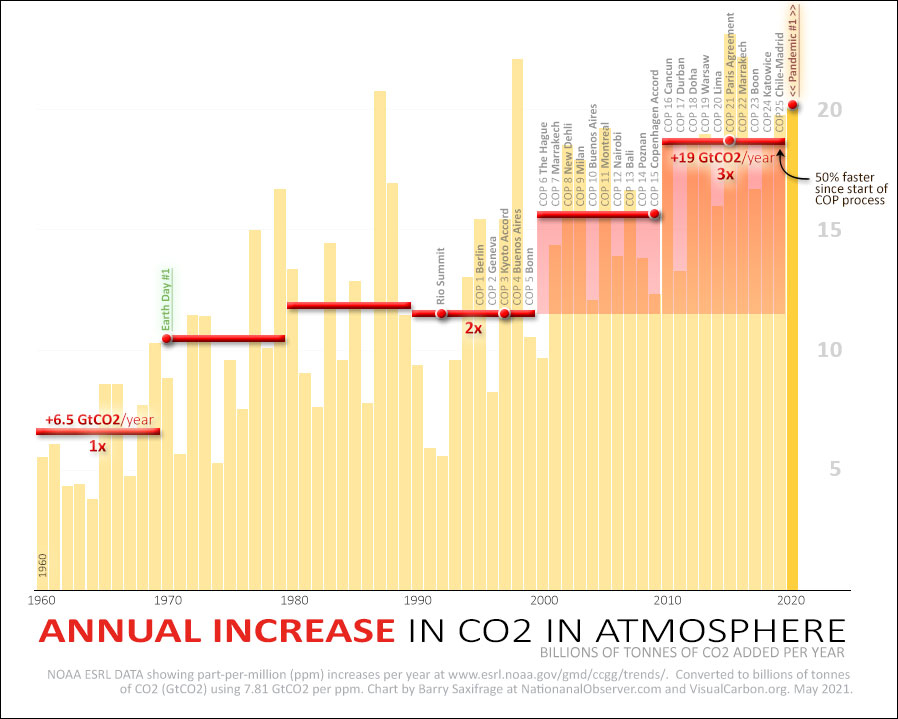
Notice how CO2 levels have increased in every single year.
The big swings seen in individual years are mostly because oceans temporarily absorb more CO2 in La Niña years, and absorb less CO2 in El Niño years. When climate data is "noisy" like this, scientists use long-term averages to see the underlying trends. The red bars do this by showing the decade averages.
These red bars show the relentless trend of the increases continuing to increase. That's what accelerating climate failure looks like.
As the leftmost red bar shows, back on the original Earth Day, the atmosphere had been gaining less than seven billion tonnes of CO2 (GtCO2) in an average year. That was enough to raise the concentration in the air by around 0.9 ppm per year. (Carbon math: 1 ppm = 7.81 GtCO2.)
By the 1990s, the decade that brought the Rio Summit and the Kyoto Accord, the atmosphere was gaining around 12 GtCO2 per year. Over the next decade, featuring the ill-fated Copenhagen Accord, CO2 poured in by an average of 15 GtCO2 more each year. And in the last decade (that included the global Paris Agreement), the atmosphere gained nearly 19 GtCO2, on average, each year.
As the chart also shows, last year, despite lower fossil fuel emissions during the global pandemic, the atmosphere gained more than 20 GtCO2, a near-record amount. This happened because a strong La Niña event caused the oceans to absorb a slightly smaller percentage of the ~34 GtCO2 we emitted from fossil fuel burning that year.
This serves as a reminder that humans are burning enough fossil fuels to double the rate the atmosphere is gaining CO2. We are critically reliant on the carbon sinks in the oceans and land to remove half of it and prevent even faster acceleration of global warming. Climate scientist James Hansen has warned many times that there is no guarantee these sinks will continue at current levels if we keep pushing the climate shifts to ever more extreme levels.
To put these increases into context, take a look at the dashed red line I added to the bottom of this chart.
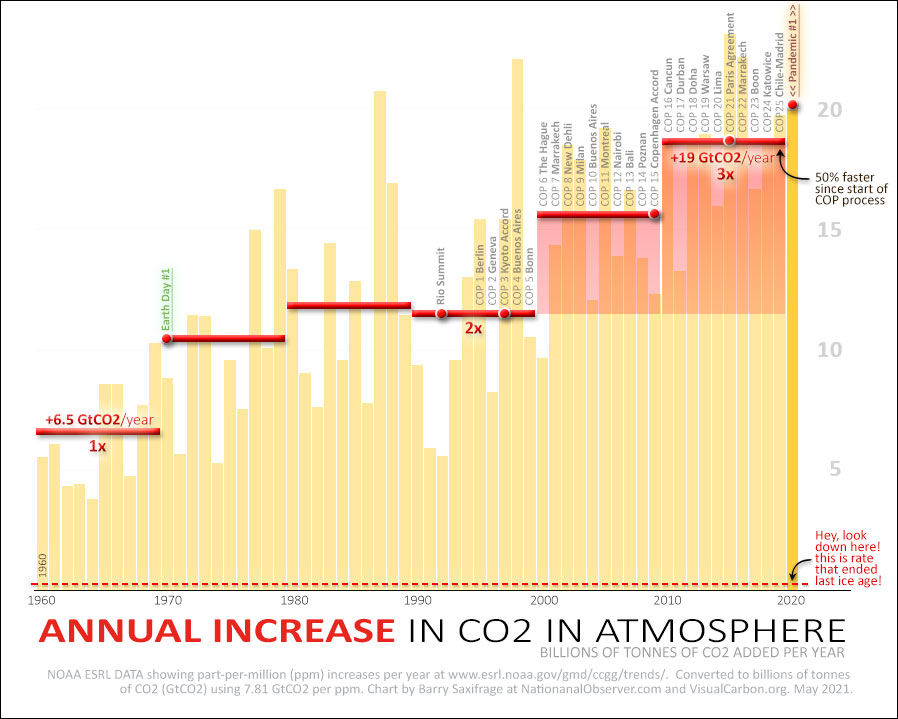
According to NOAA, “the rate of CO2 growth over the last decade is 100 to 200 times faster than what the Earth experienced during the transition from the last ice age. This is a real shock to the atmosphere.”
During the last ice age, all of Canada was buried beneath a massive northern ice cap. The ice was two miles thick over the Montreal region, and a mile thick over Vancouver. So much water was locked up in ice that global sea levels were 125 metres (410 feet) lower. That frigid global climate was heated up into the balmy one human civilization blossomed under with just that tiny trickle of CO2.
Now we are flooding the atmosphere with CO2 a hundred times faster. And rather than cut back, we just keep pressing harder on the fossil fuel accelerator.
The unmitigated, ongoing failure by the current generation to rein in our climate pollution is forcing an ever-growing burden onto future generations.
We've used their future atmosphere and oceans as an open sewer for our billions of tonnes of fossil fuel pollution that we don't want to clean up ourselves. For scale, we dump 1,000 times more climate pollution into the environment each year than we do with our other big fossil fuel waste product — plastic litter.
It has gotten so extreme that the latest climate science now says the younger generation will almost certainly have to remove massive quantities of CO2 from the atmosphere and oceans to prevent long-term dangerous climate impacts. Not just "net zero," but the even more daunting "net negative."
How can they do this if we can't? How much will it cost them? Is it even possible?
A group of climate scientists, led by James Hansen and Makiko Sato, have studied just this question. Their peer-reviewed science paper, Young People’s Burden: Requirement of Negative CO2 Emissions, concludes:
"… The GHG climate forcing is not only still growing, the growth rate is actually accelerating … if large fossil fuel emissions are allowed to continue, the scale and cost of industrial CO2 extraction, occurring in conjunction with a deteriorating climate with growing economic effects, may become unmanageable. Simply put, the burden placed on young people and future generations may become too heavy to bear."
As I covered in more detail in a recent article, Canada has been pledging to reduce our climate polluting for 33 years now. But we've never come close to meeting any of our targets.
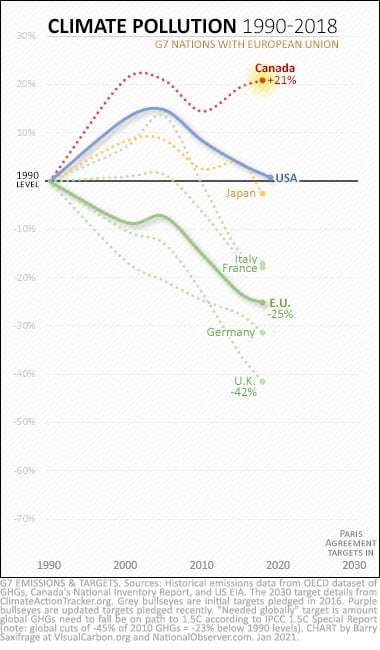
Instead, we've increased our climate polluting by 21 per cent since we started promising to emit less.
As my chart from that article shows, we are also the only member of the G7 that continues to pollute well above our 1990 levels.
Even more troubling, take a look at the most recent decade on that chart — the years when the climate crisis started to hit with increasing fury. Every other G7 country lowered emissions over those 10 years, except Canada. Ours went up.
In fact, our emissions have now risen in each of the last three years the government has released data for: 2017, 2018 and 2019. We are literally still heading in the wrong direction.
A new global poll of teenagers found that Canadian teens top the charts, with 83 per cent calling the climate situation an "emergency." Our kids don't want to live in a climate-ravaged future. Who would?
In my opinion, it is long past time for the Canadian government to do the right thing. That means abandoning the ongoing we-take-no-responsibility approach of only promising distant climate targets a decade or more into the future. That has failed us for 33 straight years.
Instead, Ottawa needs to bring in legally binding carbon budgets that cover every single year — starting with this year. That is not a radical proposal. It is exactly what our Commonwealth peer, the United Kingdom, has done starting way back in 2008. And take a look at where they are now on the chart above.
What is radical is Canada's continuing refusal to cut our sky-high climate polluting even as accelerating CO2 levels push us ever faster into a chaotic and dangerous future.
[Top graph: Despite numerous climate summits, the CO2 in our atmosphere continues to climb. Photo by Andrea Booher/FEMA/Wikimedia Commons]